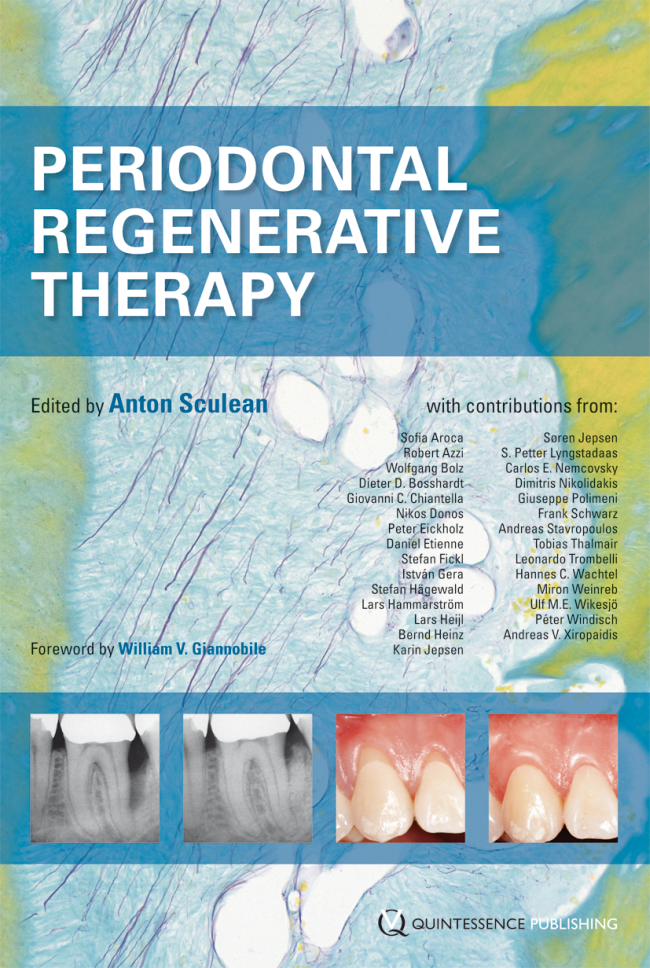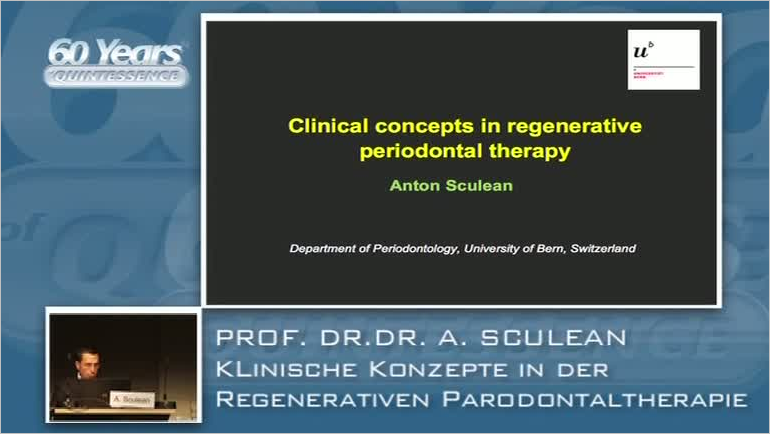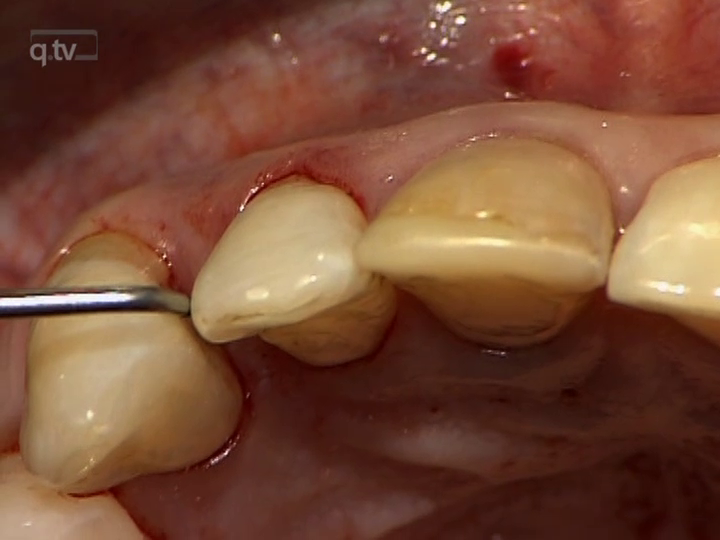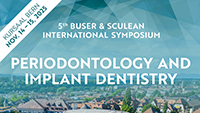Quintessence International, Pre-Print
DOI: 10.3290/j.qi.b5872198, PubMed-ID: 39636177Dezember 5, 2024,Seiten: 1-21, Sprache: EnglischFazekas, Réka / Molnár, Bálint / Sólyom, Eleonóra / Somodi, Kristóf / Palkovics, Dániel / Molnár, Eszter / Sculean, Anton / Vág, JánosObjectives: To assess blood flow alterations after horizontal Guided Bone Regeneration (GBR) and to evaluate correlations between blood flow and hard tissue changes. Method and Materials: Twelve mandibular surgical sites were involved in the current case series. GBR was carried out using a split-thickness flap design. Blood circulation was assessed with Laser Speckle Contrast Imaging at baseline as well as 1, 4, 6, 11, 13, 20, 27, and 34 days after the surgery, subsequently on a monthly basis until 6 months. Hard tissue alterations were measured horizontally and vertically using linear measurements. The first measurement point was 2 mm distal to the distal surface of the last tooth; additional measurement points were placed every 3 mm up to the 15th mm. Volumetric hard tissue loss and gain were also assessed. Results: Baseline blood circulation was statistically significantly higher on the buccal side. On the first postoperative day, all regions presented a statistically significant decrease in blood flow circulation. The buccal-inner region presented significant ischemia on day 6. Mean volumetric hard tissue gain and loss were 712.62 ± 317.08 mm3 and 222.431 ± 103.19 mm3, respectively. Mean baseline alveolar ridge width was 4.82 ± 1.02 mm, 6 months ridge width averaged 7.21 ± 0.99 mm. Vertical resorption measured 1.24 ± 0.5 mm. Correlations between blood flow changes and hard tissue alterations were only found on Day 34 and Day 60. Conclusion: Laser Speckle Contrast Imaging is an efficient method to measure flap microcirculation. No correlation was found between flap microcirculation changes hard tissue and alterations.
Schlagwörter: Bone graft, Case-report/series, Guided Bone Regeneration, Membranes, Ridge augmentation
Quintessence International, 4/2025
Open AccessDOI: 10.3290/j.qi.b5984435, PubMed-ID: 39976246Seiten: 306-317, Sprache: EnglischSchmid, Jonas Q. / Katsaros, Christos / Sculean, Anton / Galletti, Catherine / Bettenhäuser-Hartung, Lara / Janssens, YannObjective: Wire syndrome or X-effect/twist-effect describes undesired long-term tooth movements following fixed retainer placement. Since it includes root torque changes that might cause gingival recession, those situations often require periodontal, orthodontic, and conservative treatment. The aim of this study was to assess the effectiveness of fixed orthodontic treatment with completely customized lingual appliances (CCLAs) and continuous archwires for a clinically significant reduction in the dimensions of labial gingival recessions in the anterior mandible, caused by wire syndrome, in a group of consecutive patients treated with the same approach. Moreover, the reduction in root prominence of the affected teeth relative to the two neighboring teeth was evaluated. Method and materials: This retrospective cohort study from three centers included 20 consecutively recruited patients with labial gingival recession at mandibular incisors and canines due to wire syndrome. A total of 25 teeth were assessed. CCLA treatment with a standardized archwire sequence (0.012″/0.014″ NiTi, 0.016″ × 0.022″ NiTi, 0.018″ × 0.018″ beta-titanium with optional extra-torque) was identical in all three centers. Primary endpoints of recession depth, recession width, and recession surface were assessed on digital models at debonding (T1) and compared to baseline (T0) both as absolute differences (T0 − T1), and as ratios ([T0 − T1]/T0) by one-sample t tests with P .05. As a secondary endpoint, the reduction of root prominence relative to the gingival surface of the alveolar yoke of the two neighboring teeth was measured in millimeters. Results: Treatment resulted in a significant reduction in all dimensions of gingival recession. The mean reduction in recession depth was 1.86 mm (44.9%) and in recession width 0.70 mm (35.6%). The mean recession surface was reduced from 10.77 mm2 to 3.93 mm2, indicating a mean recession surface reduction of 61.4%. All changes were statistically significant (P .001). The range of recession surface reduction was from 25.4% to 100%, and 18 out of the 25 recessions showed a reduction of more than 50%. The maximum reduction in root prominence amounted to more than 3 mm. Conclusion: The use of CCLAs to torque roots of the anterior mandibular teeth, exposed by wire syndrome, towards the middle of the alveolar process reduces the area of subsequent labial gingival recession and reduces the root prominence of the affected teeth substantially. This is considered a critical step in optimizing the predictability of surgical recession coverage.
Schlagwörter: alveolar yoke, completely customized lingual appliances, gingival recessions, recession depth, recession width, retainer twist-effect, retainer X-effect, root coverage, root prominence, torque, wire syndrome
Oral Health and Preventive Dentistry, 1/2025
Open Access Online OnlyPeriodontologyDOI: 10.3290/j.ohpd.c_2078Juni 3, 2025,Seiten: 305-314, Sprache: EnglischArısan, Volkan / Sağlanmak, Alper / Anıl, Ata / Arıcı, S. Volkan / Sculean, AntonPurpose: To evaluate the efficacy of photodynamic therapy (PDT) as an adjunct to resective and regenerative surgical peri-implantitis treatment (open flap debridement via scaling and smoothening of the implant surface [implantoplasty]) combined with guided bone regeneration (GBR) in a patient cohort of a university clinic.
Materials and Methods: Seventy-two patients were treated with either conventional therapy (CON) or conventional therapy plus PDT. CON included mechanical debridement, implantoplasty, and GBR. Clinical parameters, including marginal bone level (MBL), probing pocket depth (PPD) and bleeding on probing (BOP) were assessed at baseline, 6, 12, and 18 months. The primary outcome was the resolution of the infection using a composite success criterion.
Results: After 18 months, infection resolution rates were 75% for CON and 80% for PDT groups (p = 0.75). Kaplan-Meier survival analysis showed no statistically significant difference for the infection resolution between groups (log-rank test, p = 0.6221). Both groups demonstrated statistically significant MBL gain after 6 months (mean 2.59 mm ± 1.25), with no statistically significant differences between groups throughout the follow-up. PPD was statistically significantly lower in the PDT group (two-way ANOVA, p = 0.018). BOP scores decreased initially but showed an increasing trend in both groups over time (chi-squared test, p = 0.045), with no statistically significant differences between groups.
Conclusion: PDT as an adjunct to conventional peri-implantitis treatment with GBR resulted in statistically significantly lower PPD values. However, no additional benefits were observed for infection resolution, maintenance of infection-free status, MBL or BOP. Initial improvements in both groups followed by gradual recurrences in clinical parameters over 18 months.
Schlagwörter: dental implants, guided bone regeneration, implantoplasty, peri-implantitis, photodynamic therapy
International Journal of Oral Implantology, 1/2025
PubMed-ID: 40047362Seiten: 47-57, Sprache: EnglischMonje, Alberto / Pons, Ramón / Barootchi, Shayan / Saleh, Muhammad H A / Rosen, Paul S / Sculean, AntonBackground: The treatment of advanced peri-implantitis–related bone defects is often associated with ineffective efforts to halt disease progression. The objective of this case series was to evaluate the performance of reconstructive therapy for the management of advanced peri-implantitis using recombinant human platelet-derived growth factor-BB as an adjunctive biological agent. Materials and methods: A prospective case series study on advanced intrabony peri-implantitis bone defects (≥ 50% bone loss) was performed. Clinical and radiographic variables were collected at baseline (after non-surgical therapy) and 12 months after surgical treatment. Implant surface decontamination of the intrabony component was carried out using titanium brushes and the electrolytic method. Before grafting, recombinant human platelet-derived growth factor-BB was applied on the implant surface. A mixture of mineralised allograft and xenograft hydrated with recombinant human platelet-derived growth factor-BB and covered by a collagen barrier membrane was used for reconstructive therapy. Disease resolution was defined as an absence of bleeding on probing, pocket depth 6 mm and no radiographic evidence of progressive bone loss. Descriptive statistics were performed to assess the effect of treatment on the clinical and radiographic variables. Results: A total of 10 patients exhibiting 13 advanced peri-implantitis-related bone defects were included. Implant survival at the 1-year follow-up was 100%. No major complications occurred during the early healing phase. All the clinical parameters, with the exception of keratinised mucosa, and radiographic parameters yielded statistical significance. In particular, mean pocket depth decreased by 4.5 mm and the mean Sulcus Bleeding Index was reduced by 1.8. Radiographic intrabony defects displayed a significantly narrower, shallower and less angled configuration at the 1-year follow-up. The disease resolution rate at implant level was 61.5%. Conclusion: The surgical reconstructive strategy involving the use of recombinant human platelet-derived growth factor-BB proved to be safe and effective for treating advanced peri-implantitis–related bone defects.
Schlagwörter: growth factors, guided bone regeneration, peri-implantitis
AM receives fees for lecturing and participating in other education-related events from Straumann (Basel, Switzerland) and SigmaGraft (Fullerton, CA, USA). MHAS was a scientific consultant for Lynch Biologics (Franklin, TN, USA) at the time of inception of this study. The other authors declare no conflicts of interest relating to this study.
Oral Health and Preventive Dentistry, 1/2025
Open Access Online OnlyOral MedicineDOI: 10.3290/j.ohpd.c_1910, PubMed-ID: 40146163März 27, 2025,Seiten: 203-210, Sprache: EnglischJungbauer, Gert / Lechner, Raphaela / Stähli, Alexandra / Sculean, Anton / Eick, SigrunPurpose: To investigate the antibacterial and anti-biofilm effects of two Manuka honey toothpaste formulations containing propolis (Manuka prop) or fluoride (Manuka F), in comparison with the toothpaste base (TP con) and a commercial toothpaste (TP com), on oral bacteria and biofilm. Materials and Methods: The minimum inhibitory concentration (MIC) of the formulations and controls were tested against five oral bacterial species. Both the effect on a multispecies dental biofilm precultured for 3.5 days as well as the inhibition of de-novo biofilm formation up to 24 h were investigated. Test substances at concentrations of 20%, 10% and 5% were applied to preformed biofilm for 1 min. The reduction in colony-forming units (cfu), metabolic activity, and biofilm mass were determined. Similarly, the test substances were applied to surfaces for 30 min before bacteria and media were added. The reduction of a tetrazolium dye (MTT assay) was used to assess cytotoxicity on gingival fibroblasts. Results: The MIC values of all toothpaste formulations including TP con were very low with the highest MIC of 0.04%. In precultured biofilms, both the number of colony forming units (cfu) and metabolic activity decreased following addition of any toothpaste. The greatest reductions of cfu were found after addition of 20% TP com (by about 6 log10) and after 20% Manuka prop (by about 2.3 log10). However, the biofilm mass was not reduced. Coating the surface with toothpaste formulation, the cfu in the newly formed biofilm decreased in a concentration-dependent manner, with TP com being most active. Both 20% of Manuka prop and Manuka F reduced the cfu counts more than the TP con at 24 h. The toothpaste formulations affected the viability of gingival fibroblasts in a concentration-dependent manner, with no differences observed among the formulations. Conclusion: The Manuka-honey containing toothpastes might be an alternative to toothpaste containing conventional chemical agents. Further research is needed to clinically examine the effect on caries and gingivitis prevention.
Schlagwörter: oral bacteria, oral hygiene, supragingival biofil
International Journal of Periodontics & Restorative Dentistry, 4/2024
DOI: 10.11607/prd.6626, PubMed-ID: 37819849Seiten: 434-443, Sprache: EnglischFonseca, Manrique / Molinero-Mourelle, Pedro / Dönmez, Mustafa Borga / Abou-Ayash, Samir / Buser, Daniel / Sculean, Anton / Yilmaz, BurakDental implants are commonly used to replace missing single teeth. However, esthetic rehabilitation of an adjacent tooth may also be required due to diastemas, crowding, or existing large direct restorations to improve the final esthetic outcome. With the advancements in ceramics and bonding techniques, minimally invasive esthetic approaches have become viable for compromised spacing issues. This case report describes a dental technique for the esthetic rehabilitation of compromised anterior spacing with a customized zirconia implant abutment at a maxillary central incisor site and a partial ceramic veneer bonded to the adjacent central incisor.
Schlagwörter: Anterior spacing; case report; implants; partial laminate veneer; prosthetic dentistry
Implantologie, 2/2024
Seiten: 175-189, Sprache: DeutschStähli, Alexandra / Schmid, Jan Luca / Sculean, AntonDie vorliegende Arbeit untersucht die Implantatversorgung bei Patienten mit Parodontitis im Stadium IV auf der Grundlage der neuesten Klassifikationen und Langzeitergebnisse. Parodontitis, eine chronische bakteriell induzierte Entzündung, führt zu signifikantem Gewebeverlust und beeinträchtigt die Stabilität von Implantaten, wobei die Entzündung zunächst als Mukositis ohne Knochenverlust beginnt und im weiteren Verlauf zu einer Periimplantitis führen kann. Die Inzidenz von Periimplantitis ist bei parodontal vorgeschädigten Patienten erhöht und trotz ähnlicher Überlebensraten von Implantaten nach 5 und 10 Jahren weisen diese Patienten signifikant größere Sondierungstiefen und Knochenverluste auf. Diese Arbeit unterstreicht die Notwendigkeit eines adäquaten präventiven und therapeutischen Ansatzes, einschließlich der Planung der Implantatposition und des Weichgewebemanagements sowie der Einbindung in eine regelmäßige Erhaltungstherapie, um langfristig erfolgreiche Ergebnisse zu sichern. Diese Konzepte werden abschließend anhand eines Patientenbeispiels erläutert.
Schlagwörter: Parodontitis im Stadium IV, Zahnimplantate, unterstützende Parodontalbehandlung
Oral Health and Preventive Dentistry, 1/2024
Open Access Online OnlyPeriodontologyDOI: 10.3290/j.ohpd.b5281925, PubMed-ID: 38687029April 30, 2024,Seiten: 171-180, Sprache: EnglischRamanauskaite, Egle / Machiulskiene Visockiene, Vita / Shirakata, Yoshinori / Friedmann, Anton / Pereckaite, Laura / Balciunaite, Ausra / Dvyliene, Urte Marija / Vitkauskiene, Astra / Baseviciene, Nomeda / Sculean, AntonPurpose: To investigate the microbiological outcomes obtained with either subgingival debridement (SD) in conjunction with a gel containing sodium hypochlorite and amino acids followed by subsequent application of a cross-linked hyaluronic acid gel (xHyA) gel, or with SD alone.
Materials and Methods: Forty-eight patients diagnosed with stages II-III (grades A/B) generalised periodontitis were randomly treated with either SD (control) or SD plus adjunctive sodium hypochlorite/amino acids and xHyA gel (test). Subgingival plaque samples were collected from the deepest site per quadrant in each patient at baseline and after 3 and 6 months. Pooled sample analysis was performed using a multiplex polymerase chain reaction (PCR)-based method for the identification of detection frequencies and changes in numbers of the following bacteria: Aggregatibacter actinomycetemcomitans (A.a), Porphyromonas gingivalis (P.g), Tannerella forsythia (T.f), Treponema denticola (T.d), and Prevotella intermedia (P.i).
Results: In terms of detection frequency, in the test group, statistically significant reductions were found for P.g, T.f, T.d and P.i (p < 0.05) after 6 months. In the control group, the detection frequencies of all investigated bacterial species at 6 months were comparable to the baseline values (p > 0.05). The comparison of the test and control groups revealed statistically significant differences in detection frequency for P.g (p = 0.034), T.d (p < 0.01) and P.i (p = 0.02) after 6 months, favouring the test group. Regarding reduction in detection frequency scores, at 6 months, statistically significant differences in favour of the test group were observed for all investigated bacterial species: A.a (p = 0.028), P.g (p = 0.028), T.f (p = 0.004), T.d (p <0.001), and P.i (p = 0.003).
Conclusions: The present microbiological results, which are related to short-term outcomes up to 6 months post-treatment, support the adjunctive subgingival application of sodium hypochlorite/amino acids and xHyA to subgingival debridement in the treatment of periodontitis.
Schlagwörter: cross-linked hyaluronic acid, microbiology, non-surgical periodontal therapy, periodontitis, periopathogenic bacteria, sodium hypochlorite/amino acids
Oral Health and Preventive Dentistry, 1/2024
Open Access Online OnlyEPIDEMIOLOGYDOI: 10.3290/j.ohpd.b5866891, PubMed-ID: 39625349Dezember 3, 2024,Seiten: 631-638, Sprache: EnglischStähli, Alexandra / Nhan, Rui Fang / Schäfer, Janika Michelle / Imber, Jean-Claude / Roccuzzo, Andrea / Sculean, Anton / Schimmel, Martin / Tennert, Christian / Eick, SigrunPurpose: The COVID-19 pandemic raised the question about the extent of microbial exposure encountered by dentists during dental therapy. The purpose of this study was to quantify microbial counts on surgical masks related to duration and type of dental therapy, as well as patient oral health variables.
Materials and Methods: Sterile filter papers were fixed on surgical masks used during routine daily dental therapy. Thereafter, the filter papers were pressed onto blood agar plates for 1 min, before the agar plates were incubated with 10% CO2. After 48 h, the colony forming units (CFU) were counted and microorganisms were identified. The dependence of the CFU counts on treatment and patient-related variables was analysed using linear regression.
Results: Filter papers obtained from 322 dental treatments (429 masks) were included in the final analysis. On average, 5.41 ± 9.94 CFUs were counted. While mostly oral bacteria were detected, Staphylococcus aureus was also identified on 16 masks. Linear regression, incorporating patient-related and treatment characteristics through step-wise inclusion, revealed statistical significance (p 0.001) only with the variable “assistance during therapy”. The type of dental treatment exhibited a trend, with fewer CFUs observed in caries treatment compared to periodontal or prosthodontic therapy. Furthermore, after analysing filter papers from masks used by dental assistants in 107 dental treatments, fewer CFUs were found on the masks compared to those used by dentists (p 0.001).
Conclusion: The mean number of CFUs observed consistently remained low, highlighting the efficacy of the implemented hygiene measures. Consequently, it is clinically recommended to support dental treatment with precise suction of the generated aerosols.
Schlagwörter: aerosols, dental care, dental care team, masks
Oral Health and Preventive Dentistry, 1/2024
Open Access Online OnlyOral HealthDOI: 10.3290/j.ohpd.b4997035, PubMed-ID: 38376435Februar 20, 2024,Seiten: 115-122, Sprache: EnglischWolf, Thomas Gerhard / Dianišková, Simona / Cavallé, Edoardo / Aliyeva, Rena / Cagetti, Maria-Grazia / Campus, Guglielmo / Deschner, James / Forna, Norina / Ilhan, Duygu / Mazevet, Marco / Lella, Anna / Melo, Paulo / Perlea, Paula / Rovera, Angela / Sculean, Anton / Sharkov, Nikolai / Slutsky, Ariel / Torres, António Roma / Saag, MarePurpose: Dental students learn knowledge and practical skills to provide oral health care to the population. Practical skills must be maintained or continuously developed throughout a professional career. This cross-sectional survey aimed to evaluate the perception of practical skills of dental students and dental-school graduates by national dental associations (NDAs) in international comparison in the European Regional Organization of the FDI World Dental Federation (ERO-FDI) zone.
Materials and Methods: A questionnaire of 14 items collected information on pre-/postgraduate areas.
Results: A total of 25 countries participated (response rate: 69.4%), with 80.0% having minimum requirements for practical skills acquisition and 64.0% starting practical training in the 3rd year of study. In countries where clinical practical work on patients begins in the 2nd year of study, practical skills of graduates are perceived as average, starting in the 3rd year of study as mainly good, starting in the 4th as varying widely from poor to very good. In total, 76.0% of respondents feel that improvements are needed before entering dental practice. Improvements could be reached by treating more patients in dental school (32.0%), increasing the quantity of clinical training (20.0%), or having more clinical instructors (12.0%). In 56.0% of the countries, it is possible to open one’s own dental practice immediately after graduation, and in 16.0%, prior vocational training is mandatory.
Conclusions: All participating countries in the ERO-FDI zone reported practical training in dental school, most starting in the 3rd year of study. The perception of practical skills of dental students and dental-school graduates among NDAs is very heterogeneous. Reasons for the perceived deficiencies should be further explored.
Schlagwörter: dental association, graduate, international, practical skills, student

























